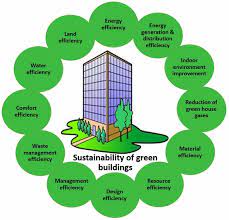Green data center
Courtesy : www.huawei.com/
In the last decade, the need for data centers has grown tremendously. The numerous benefits of migrating business to data centers include cost savings, up-to-date security measures, power and utilities consumption monitoring, and several others.
For example, public cloud services provide users access to cloud resources at a minimal subscription fee. The customer just needs to move his applications to the public cloud, without having to face any upfront initial IT infrastructure costs. Data centers also allow customers to achieve high availability as it supports clustering of hardware infrastructure and failover mechanisms. Server clusters ensure uninterrupted business continuity even when a server fails since it would offload the work onto another standby server.
What green data centers bring to the table
The massive amount of data being created has driven the need for companies to house their business-critical workloads and applications within data centers. According to the World Economic Forum, the amount of data estimated at the beginning of 2020 was around 44 zettabytes. By 2025 however, about 463 exabytes of data will be created each day globally. For context, a smartphone comes with 64GB of built-in storage, which is 0.0000000064 of an exabyte. To create 1 exabyte of data from a video call, the call would need to last for 2,37,832 years!
Investment in data centers is growing, and the expansion of the public cloud is catalyzing the need to have large data centers across various geographies. Large enterprises have recently announced some of their biggest investments into data centers:
Source: Amazon, Microsoft New Zealand, Google, Oracle, Microsoft Malaysia
Data centers are one of the highest energy consumers across the globe. Some of the world’s biggest data centers contain tens of thousands of IT infrastructure devices each, that require more than 100 megawatts of power to operate–this is potentially enough to power 80,000 U.S. homes! (U.S. DOE 2020).
As more data is generated every day, companies are in search of ways to store and process data with minimal environmental impact. A couple of years ago, sustainable practices and going green were considered to be a forward-thinking approach. But with increased awareness of worldwide energy needs, the severity of climate change, and the impact of carbon footprint, they are required, now more than ever.
With data centers being one of the largest energy consumers, it comes as no surprise that energy is one of the biggest costs for data center infrastructure management (DCIM) software. The need to ensure that all servers are up and running to prevent any downtime is critical. Data center components require cooling systems in place for the servers to prevent them from overheating, in addition to overall maintenance, electricity charges, water supply, and other utilities requirements. These tasks consume a large amount of energy, and therefore it’s absolutely necessary to ensure sustainable practices are in place. DCIM and building management systems (BMS) software are helping data center service providers manage their infrastructure to improve operating efficiencies, all the while meeting sustainability goals.
According to a report from ReportLinker, the DCIM market is expected to see a growing demand in North America—one of the key reasons being the increasing emphasis on energy-efficient data centers. At G2, we observed the growth trajectory for our DCIM Software category which saw a significant rise of 104.16% between November 2020 and March 2021.
What is a Green Data Center?
A green data center is a sustainable data center that uses energy efficiency technologies. Computer systems, mechanical equipment, lighting, and electrical systems are designed to ensure maximum energy efficiency to reduce environmental impact.
Key examples of green data center initiatives include waste management, adopting alternative energy technologies, using low-emission materials, and several others.
Are my competitors talking about going green?
Yes! Several vendors have released products and software that support the green data center initiatives. For instance, in February 2021, Atos and HDF Energy announced their plan to develop a complete end-to-end long-term solution to supply data centers with green hydrogen generated by renewable energy. Under this plan, Atos will design and provide the hardware, software, and integration services that use electricity produced by green hydrogen. Artificial intelligence (AI) will support the solution to predict the data center’s power consumption needs and adapt to green hydrogen accordingly.
In another interesting example, an important breakthrough in green data center management came from Microsoft, wherein the company shared that underwater data centers are reliable, practical, and support sustainable energy usage. In the summer of 2020, the firm reeled up a containerized data center that was submerged 117 feet underwater back in spring 2018.
Consistently cool subsurfaces of the sea allowed for efficient data center design along with increased resistance to corrosion as compared to data centers on land. These data centers use heat exchange plumbing that is usually found in submarines. This could change the way data centers talk about going green–having small containerized data centers located closer to customer location to reduce latency and maintain energy efficiency since it is stored deep in the ocean. This would eliminate the need to construct large data centers on land, which translates to minimum or no requirement for multiple cooling systems, air conditioning, and office complexes traditionally installed in a data center.




